The Impact of Tourism on South Korea: A Comprehensive Report
VerifiedAdded on 2023/05/27
|5
|2658
|500
Report
AI Summary
This report provides a comprehensive analysis of the impact of tourism on South Korea, examining both its economic and social-cultural effects. The study highlights tourism's significant contribution to the country's GDP, job creation, and infrastructure development. It details the direct and indirect employment opportunities created by the tourism sector, including airlines, hotels, transportation services, and related industries. The report also explores the influence of tourism on South Korean society, including its effects on cultural preservation, social interactions, and living standards. The analysis covers the preservation of cultural heritage, the promotion of international relations, and the impact on social acceptance and lifestyle changes. While acknowledging the positive aspects, the report also touches upon potential negative social impacts, such as social polarization and seasonal employment challenges. The report references various studies and statistics to support its findings, offering a detailed overview of the multifaceted impacts of tourism in South Korea.
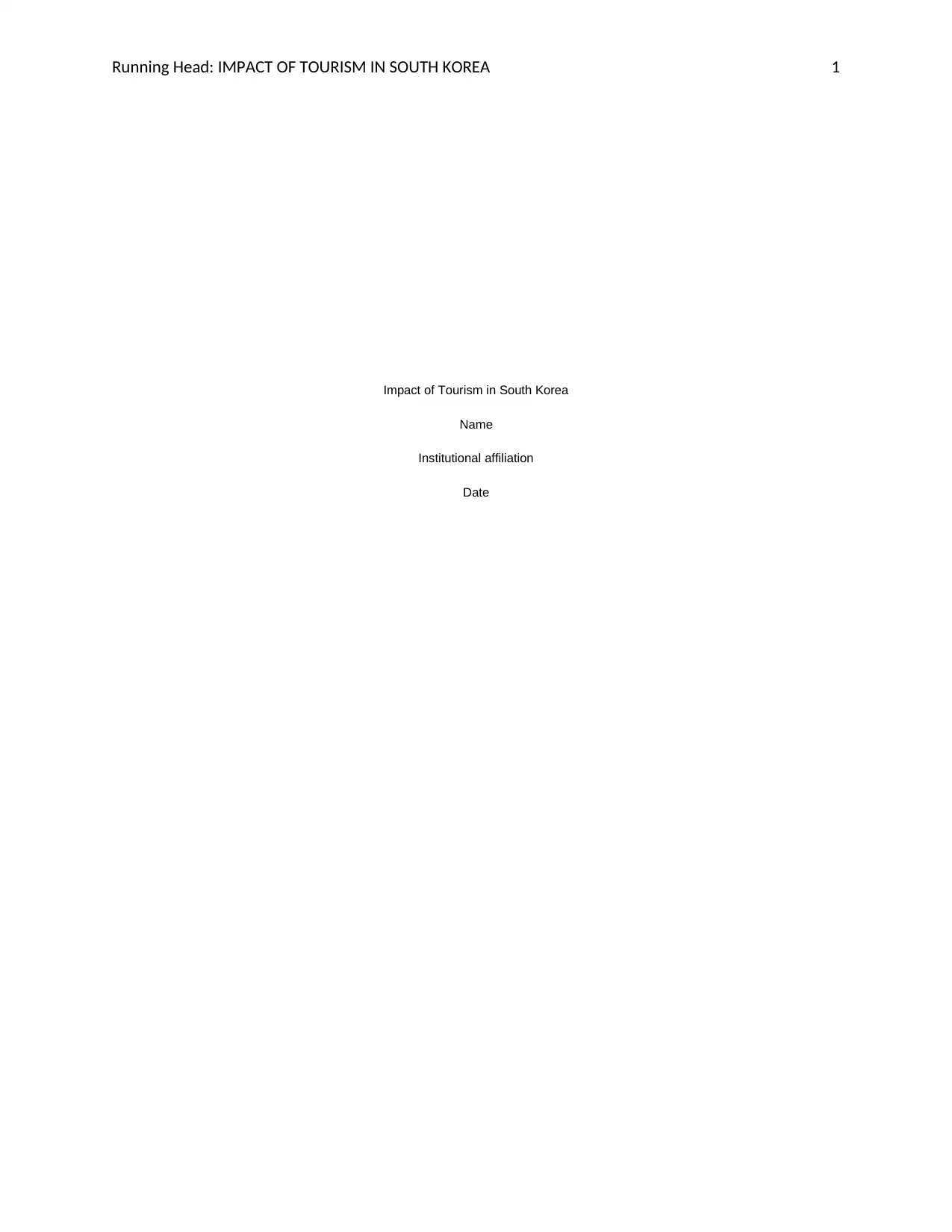
Running Head: IMPACT OF TOURISM IN SOUTH KOREA 1
Impact of Tourism in South Korea
Name
Institutional affiliation
Date
Impact of Tourism in South Korea
Name
Institutional affiliation
Date
Paraphrase This Document
Need a fresh take? Get an instant paraphrase of this document with our AI Paraphraser
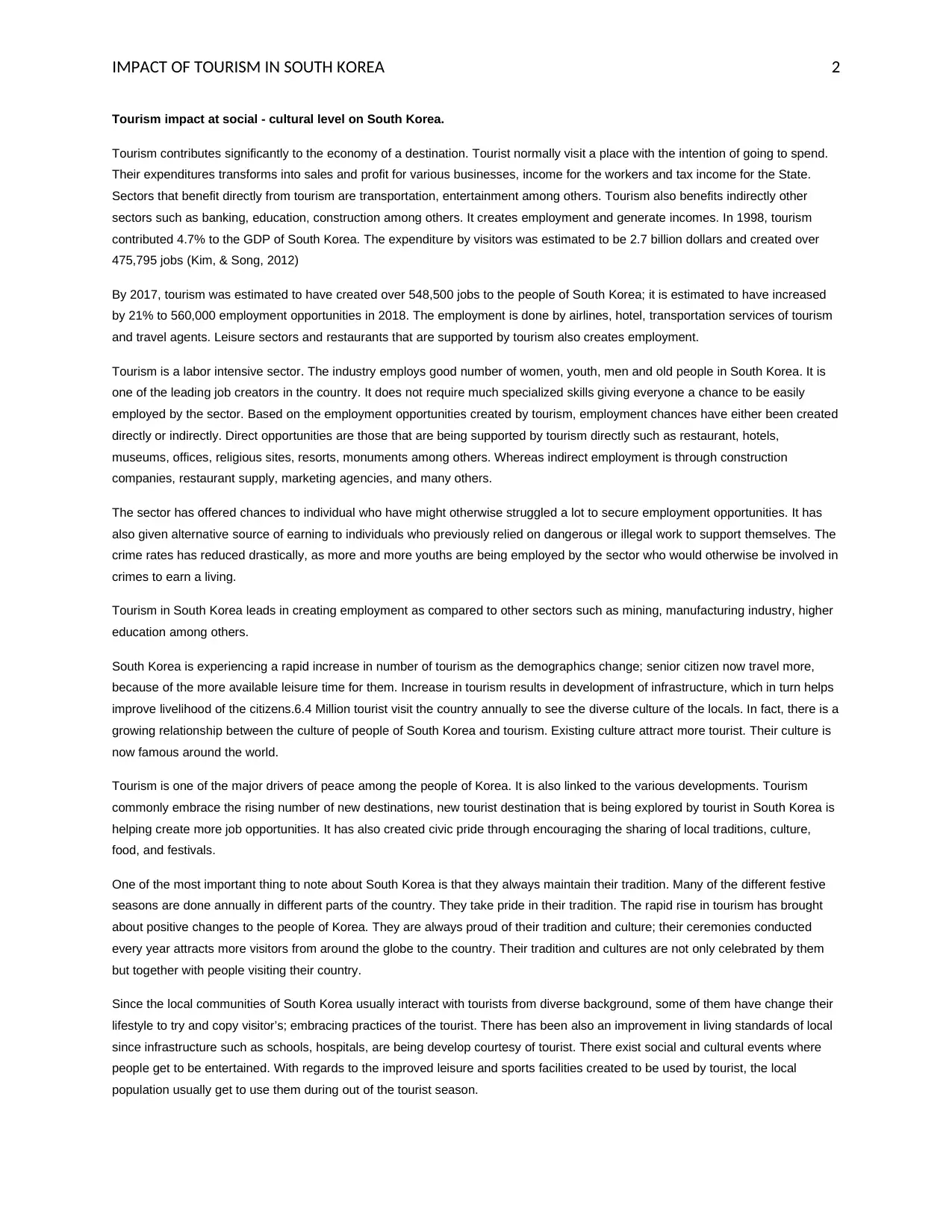
IMPACT OF TOURISM IN SOUTH KOREA 2
Tourism impact at social - cultural level on South Korea.
Tourism contributes significantly to the economy of a destination. Tourist normally visit a place with the intention of going to spend.
Their expenditures transforms into sales and profit for various businesses, income for the workers and tax income for the State.
Sectors that benefit directly from tourism are transportation, entertainment among others. Tourism also benefits indirectly other
sectors such as banking, education, construction among others. It creates employment and generate incomes. In 1998, tourism
contributed 4.7% to the GDP of South Korea. The expenditure by visitors was estimated to be 2.7 billion dollars and created over
475,795 jobs (Kim, & Song, 2012)
By 2017, tourism was estimated to have created over 548,500 jobs to the people of South Korea; it is estimated to have increased
by 21% to 560,000 employment opportunities in 2018. The employment is done by airlines, hotel, transportation services of tourism
and travel agents. Leisure sectors and restaurants that are supported by tourism also creates employment.
Tourism is a labor intensive sector. The industry employs good number of women, youth, men and old people in South Korea. It is
one of the leading job creators in the country. It does not require much specialized skills giving everyone a chance to be easily
employed by the sector. Based on the employment opportunities created by tourism, employment chances have either been created
directly or indirectly. Direct opportunities are those that are being supported by tourism directly such as restaurant, hotels,
museums, offices, religious sites, resorts, monuments among others. Whereas indirect employment is through construction
companies, restaurant supply, marketing agencies, and many others.
The sector has offered chances to individual who have might otherwise struggled a lot to secure employment opportunities. It has
also given alternative source of earning to individuals who previously relied on dangerous or illegal work to support themselves. The
crime rates has reduced drastically, as more and more youths are being employed by the sector who would otherwise be involved in
crimes to earn a living.
Tourism in South Korea leads in creating employment as compared to other sectors such as mining, manufacturing industry, higher
education among others.
South Korea is experiencing a rapid increase in number of tourism as the demographics change; senior citizen now travel more,
because of the more available leisure time for them. Increase in tourism results in development of infrastructure, which in turn helps
improve livelihood of the citizens.6.4 Million tourist visit the country annually to see the diverse culture of the locals. In fact, there is a
growing relationship between the culture of people of South Korea and tourism. Existing culture attract more tourist. Their culture is
now famous around the world.
Tourism is one of the major drivers of peace among the people of Korea. It is also linked to the various developments. Tourism
commonly embrace the rising number of new destinations, new tourist destination that is being explored by tourist in South Korea is
helping create more job opportunities. It has also created civic pride through encouraging the sharing of local traditions, culture,
food, and festivals.
One of the most important thing to note about South Korea is that they always maintain their tradition. Many of the different festive
seasons are done annually in different parts of the country. They take pride in their tradition. The rapid rise in tourism has brought
about positive changes to the people of Korea. They are always proud of their tradition and culture; their ceremonies conducted
every year attracts more visitors from around the globe to the country. Their tradition and cultures are not only celebrated by them
but together with people visiting their country.
Since the local communities of South Korea usually interact with tourists from diverse background, some of them have change their
lifestyle to try and copy visitor’s; embracing practices of the tourist. There has been also an improvement in living standards of local
since infrastructure such as schools, hospitals, are being develop courtesy of tourist. There exist social and cultural events where
people get to be entertained. With regards to the improved leisure and sports facilities created to be used by tourist, the local
population usually get to use them during out of the tourist season.
Tourism impact at social - cultural level on South Korea.
Tourism contributes significantly to the economy of a destination. Tourist normally visit a place with the intention of going to spend.
Their expenditures transforms into sales and profit for various businesses, income for the workers and tax income for the State.
Sectors that benefit directly from tourism are transportation, entertainment among others. Tourism also benefits indirectly other
sectors such as banking, education, construction among others. It creates employment and generate incomes. In 1998, tourism
contributed 4.7% to the GDP of South Korea. The expenditure by visitors was estimated to be 2.7 billion dollars and created over
475,795 jobs (Kim, & Song, 2012)
By 2017, tourism was estimated to have created over 548,500 jobs to the people of South Korea; it is estimated to have increased
by 21% to 560,000 employment opportunities in 2018. The employment is done by airlines, hotel, transportation services of tourism
and travel agents. Leisure sectors and restaurants that are supported by tourism also creates employment.
Tourism is a labor intensive sector. The industry employs good number of women, youth, men and old people in South Korea. It is
one of the leading job creators in the country. It does not require much specialized skills giving everyone a chance to be easily
employed by the sector. Based on the employment opportunities created by tourism, employment chances have either been created
directly or indirectly. Direct opportunities are those that are being supported by tourism directly such as restaurant, hotels,
museums, offices, religious sites, resorts, monuments among others. Whereas indirect employment is through construction
companies, restaurant supply, marketing agencies, and many others.
The sector has offered chances to individual who have might otherwise struggled a lot to secure employment opportunities. It has
also given alternative source of earning to individuals who previously relied on dangerous or illegal work to support themselves. The
crime rates has reduced drastically, as more and more youths are being employed by the sector who would otherwise be involved in
crimes to earn a living.
Tourism in South Korea leads in creating employment as compared to other sectors such as mining, manufacturing industry, higher
education among others.
South Korea is experiencing a rapid increase in number of tourism as the demographics change; senior citizen now travel more,
because of the more available leisure time for them. Increase in tourism results in development of infrastructure, which in turn helps
improve livelihood of the citizens.6.4 Million tourist visit the country annually to see the diverse culture of the locals. In fact, there is a
growing relationship between the culture of people of South Korea and tourism. Existing culture attract more tourist. Their culture is
now famous around the world.
Tourism is one of the major drivers of peace among the people of Korea. It is also linked to the various developments. Tourism
commonly embrace the rising number of new destinations, new tourist destination that is being explored by tourist in South Korea is
helping create more job opportunities. It has also created civic pride through encouraging the sharing of local traditions, culture,
food, and festivals.
One of the most important thing to note about South Korea is that they always maintain their tradition. Many of the different festive
seasons are done annually in different parts of the country. They take pride in their tradition. The rapid rise in tourism has brought
about positive changes to the people of Korea. They are always proud of their tradition and culture; their ceremonies conducted
every year attracts more visitors from around the globe to the country. Their tradition and cultures are not only celebrated by them
but together with people visiting their country.
Since the local communities of South Korea usually interact with tourists from diverse background, some of them have change their
lifestyle to try and copy visitor’s; embracing practices of the tourist. There has been also an improvement in living standards of local
since infrastructure such as schools, hospitals, are being develop courtesy of tourist. There exist social and cultural events where
people get to be entertained. With regards to the improved leisure and sports facilities created to be used by tourist, the local
population usually get to use them during out of the tourist season.
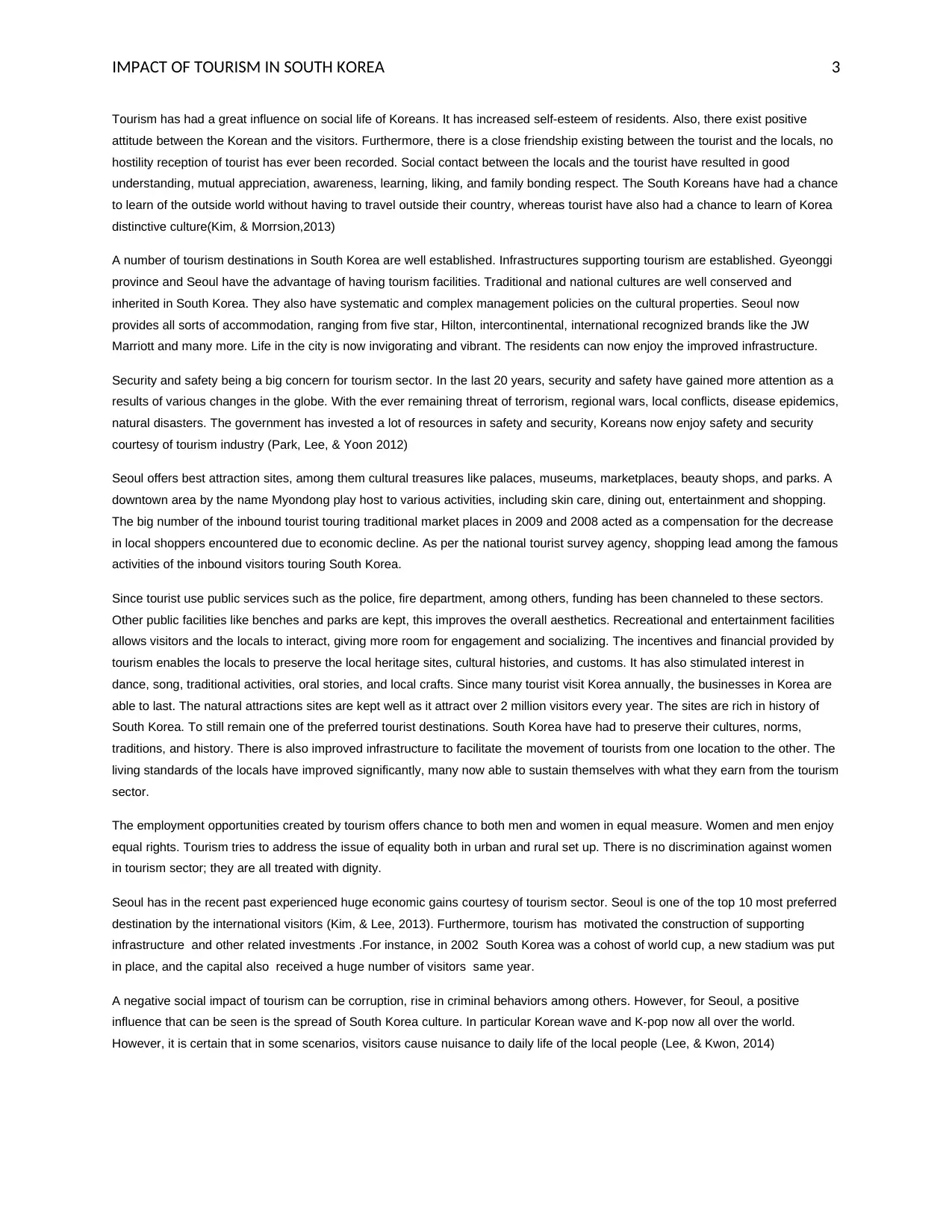
IMPACT OF TOURISM IN SOUTH KOREA 3
Tourism has had a great influence on social life of Koreans. It has increased self-esteem of residents. Also, there exist positive
attitude between the Korean and the visitors. Furthermore, there is a close friendship existing between the tourist and the locals, no
hostility reception of tourist has ever been recorded. Social contact between the locals and the tourist have resulted in good
understanding, mutual appreciation, awareness, learning, liking, and family bonding respect. The South Koreans have had a chance
to learn of the outside world without having to travel outside their country, whereas tourist have also had a chance to learn of Korea
distinctive culture(Kim, & Morrsion,2013)
A number of tourism destinations in South Korea are well established. Infrastructures supporting tourism are established. Gyeonggi
province and Seoul have the advantage of having tourism facilities. Traditional and national cultures are well conserved and
inherited in South Korea. They also have systematic and complex management policies on the cultural properties. Seoul now
provides all sorts of accommodation, ranging from five star, Hilton, intercontinental, international recognized brands like the JW
Marriott and many more. Life in the city is now invigorating and vibrant. The residents can now enjoy the improved infrastructure.
Security and safety being a big concern for tourism sector. In the last 20 years, security and safety have gained more attention as a
results of various changes in the globe. With the ever remaining threat of terrorism, regional wars, local conflicts, disease epidemics,
natural disasters. The government has invested a lot of resources in safety and security, Koreans now enjoy safety and security
courtesy of tourism industry (Park, Lee, & Yoon 2012)
Seoul offers best attraction sites, among them cultural treasures like palaces, museums, marketplaces, beauty shops, and parks. A
downtown area by the name Myondong play host to various activities, including skin care, dining out, entertainment and shopping.
The big number of the inbound tourist touring traditional market places in 2009 and 2008 acted as a compensation for the decrease
in local shoppers encountered due to economic decline. As per the national tourist survey agency, shopping lead among the famous
activities of the inbound visitors touring South Korea.
Since tourist use public services such as the police, fire department, among others, funding has been channeled to these sectors.
Other public facilities like benches and parks are kept, this improves the overall aesthetics. Recreational and entertainment facilities
allows visitors and the locals to interact, giving more room for engagement and socializing. The incentives and financial provided by
tourism enables the locals to preserve the local heritage sites, cultural histories, and customs. It has also stimulated interest in
dance, song, traditional activities, oral stories, and local crafts. Since many tourist visit Korea annually, the businesses in Korea are
able to last. The natural attractions sites are kept well as it attract over 2 million visitors every year. The sites are rich in history of
South Korea. To still remain one of the preferred tourist destinations. South Korea have had to preserve their cultures, norms,
traditions, and history. There is also improved infrastructure to facilitate the movement of tourists from one location to the other. The
living standards of the locals have improved significantly, many now able to sustain themselves with what they earn from the tourism
sector.
The employment opportunities created by tourism offers chance to both men and women in equal measure. Women and men enjoy
equal rights. Tourism tries to address the issue of equality both in urban and rural set up. There is no discrimination against women
in tourism sector; they are all treated with dignity.
Seoul has in the recent past experienced huge economic gains courtesy of tourism sector. Seoul is one of the top 10 most preferred
destination by the international visitors (Kim, & Lee, 2013). Furthermore, tourism has motivated the construction of supporting
infrastructure and other related investments .For instance, in 2002 South Korea was a cohost of world cup, a new stadium was put
in place, and the capital also received a huge number of visitors same year.
A negative social impact of tourism can be corruption, rise in criminal behaviors among others. However, for Seoul, a positive
influence that can be seen is the spread of South Korea culture. In particular Korean wave and K-pop now all over the world.
However, it is certain that in some scenarios, visitors cause nuisance to daily life of the local people (Lee, & Kwon, 2014)
Tourism has had a great influence on social life of Koreans. It has increased self-esteem of residents. Also, there exist positive
attitude between the Korean and the visitors. Furthermore, there is a close friendship existing between the tourist and the locals, no
hostility reception of tourist has ever been recorded. Social contact between the locals and the tourist have resulted in good
understanding, mutual appreciation, awareness, learning, liking, and family bonding respect. The South Koreans have had a chance
to learn of the outside world without having to travel outside their country, whereas tourist have also had a chance to learn of Korea
distinctive culture(Kim, & Morrsion,2013)
A number of tourism destinations in South Korea are well established. Infrastructures supporting tourism are established. Gyeonggi
province and Seoul have the advantage of having tourism facilities. Traditional and national cultures are well conserved and
inherited in South Korea. They also have systematic and complex management policies on the cultural properties. Seoul now
provides all sorts of accommodation, ranging from five star, Hilton, intercontinental, international recognized brands like the JW
Marriott and many more. Life in the city is now invigorating and vibrant. The residents can now enjoy the improved infrastructure.
Security and safety being a big concern for tourism sector. In the last 20 years, security and safety have gained more attention as a
results of various changes in the globe. With the ever remaining threat of terrorism, regional wars, local conflicts, disease epidemics,
natural disasters. The government has invested a lot of resources in safety and security, Koreans now enjoy safety and security
courtesy of tourism industry (Park, Lee, & Yoon 2012)
Seoul offers best attraction sites, among them cultural treasures like palaces, museums, marketplaces, beauty shops, and parks. A
downtown area by the name Myondong play host to various activities, including skin care, dining out, entertainment and shopping.
The big number of the inbound tourist touring traditional market places in 2009 and 2008 acted as a compensation for the decrease
in local shoppers encountered due to economic decline. As per the national tourist survey agency, shopping lead among the famous
activities of the inbound visitors touring South Korea.
Since tourist use public services such as the police, fire department, among others, funding has been channeled to these sectors.
Other public facilities like benches and parks are kept, this improves the overall aesthetics. Recreational and entertainment facilities
allows visitors and the locals to interact, giving more room for engagement and socializing. The incentives and financial provided by
tourism enables the locals to preserve the local heritage sites, cultural histories, and customs. It has also stimulated interest in
dance, song, traditional activities, oral stories, and local crafts. Since many tourist visit Korea annually, the businesses in Korea are
able to last. The natural attractions sites are kept well as it attract over 2 million visitors every year. The sites are rich in history of
South Korea. To still remain one of the preferred tourist destinations. South Korea have had to preserve their cultures, norms,
traditions, and history. There is also improved infrastructure to facilitate the movement of tourists from one location to the other. The
living standards of the locals have improved significantly, many now able to sustain themselves with what they earn from the tourism
sector.
The employment opportunities created by tourism offers chance to both men and women in equal measure. Women and men enjoy
equal rights. Tourism tries to address the issue of equality both in urban and rural set up. There is no discrimination against women
in tourism sector; they are all treated with dignity.
Seoul has in the recent past experienced huge economic gains courtesy of tourism sector. Seoul is one of the top 10 most preferred
destination by the international visitors (Kim, & Lee, 2013). Furthermore, tourism has motivated the construction of supporting
infrastructure and other related investments .For instance, in 2002 South Korea was a cohost of world cup, a new stadium was put
in place, and the capital also received a huge number of visitors same year.
A negative social impact of tourism can be corruption, rise in criminal behaviors among others. However, for Seoul, a positive
influence that can be seen is the spread of South Korea culture. In particular Korean wave and K-pop now all over the world.
However, it is certain that in some scenarios, visitors cause nuisance to daily life of the local people (Lee, & Kwon, 2014)
⊘ This is a preview!⊘
Do you want full access?
Subscribe today to unlock all pages.

Trusted by 1+ million students worldwide
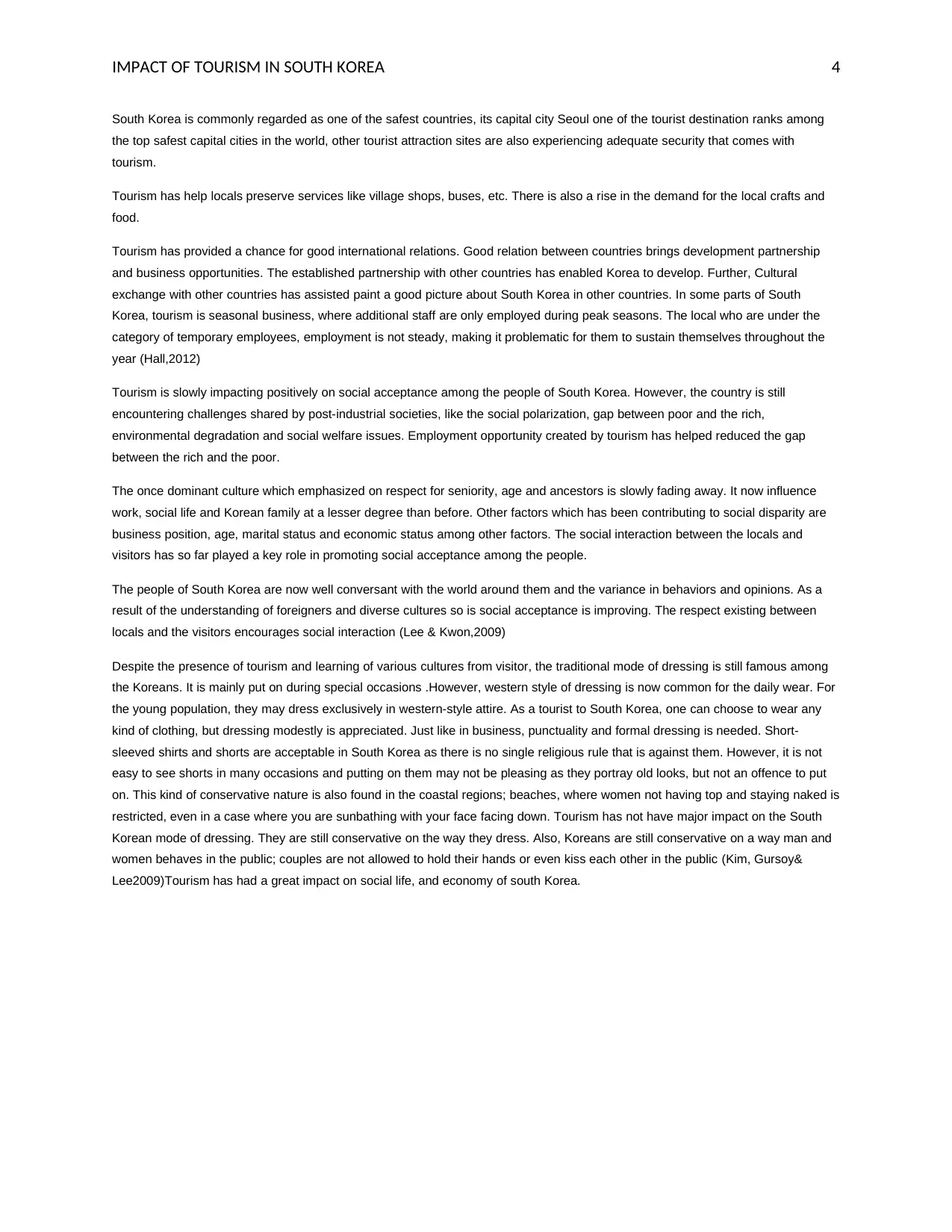
IMPACT OF TOURISM IN SOUTH KOREA 4
South Korea is commonly regarded as one of the safest countries, its capital city Seoul one of the tourist destination ranks among
the top safest capital cities in the world, other tourist attraction sites are also experiencing adequate security that comes with
tourism.
Tourism has help locals preserve services like village shops, buses, etc. There is also a rise in the demand for the local crafts and
food.
Tourism has provided a chance for good international relations. Good relation between countries brings development partnership
and business opportunities. The established partnership with other countries has enabled Korea to develop. Further, Cultural
exchange with other countries has assisted paint a good picture about South Korea in other countries. In some parts of South
Korea, tourism is seasonal business, where additional staff are only employed during peak seasons. The local who are under the
category of temporary employees, employment is not steady, making it problematic for them to sustain themselves throughout the
year (Hall,2012)
Tourism is slowly impacting positively on social acceptance among the people of South Korea. However, the country is still
encountering challenges shared by post-industrial societies, like the social polarization, gap between poor and the rich,
environmental degradation and social welfare issues. Employment opportunity created by tourism has helped reduced the gap
between the rich and the poor.
The once dominant culture which emphasized on respect for seniority, age and ancestors is slowly fading away. It now influence
work, social life and Korean family at a lesser degree than before. Other factors which has been contributing to social disparity are
business position, age, marital status and economic status among other factors. The social interaction between the locals and
visitors has so far played a key role in promoting social acceptance among the people.
The people of South Korea are now well conversant with the world around them and the variance in behaviors and opinions. As a
result of the understanding of foreigners and diverse cultures so is social acceptance is improving. The respect existing between
locals and the visitors encourages social interaction (Lee & Kwon,2009)
Despite the presence of tourism and learning of various cultures from visitor, the traditional mode of dressing is still famous among
the Koreans. It is mainly put on during special occasions .However, western style of dressing is now common for the daily wear. For
the young population, they may dress exclusively in western-style attire. As a tourist to South Korea, one can choose to wear any
kind of clothing, but dressing modestly is appreciated. Just like in business, punctuality and formal dressing is needed. Short-
sleeved shirts and shorts are acceptable in South Korea as there is no single religious rule that is against them. However, it is not
easy to see shorts in many occasions and putting on them may not be pleasing as they portray old looks, but not an offence to put
on. This kind of conservative nature is also found in the coastal regions; beaches, where women not having top and staying naked is
restricted, even in a case where you are sunbathing with your face facing down. Tourism has not have major impact on the South
Korean mode of dressing. They are still conservative on the way they dress. Also, Koreans are still conservative on a way man and
women behaves in the public; couples are not allowed to hold their hands or even kiss each other in the public (Kim, Gursoy&
Lee2009)Tourism has had a great impact on social life, and economy of south Korea.
South Korea is commonly regarded as one of the safest countries, its capital city Seoul one of the tourist destination ranks among
the top safest capital cities in the world, other tourist attraction sites are also experiencing adequate security that comes with
tourism.
Tourism has help locals preserve services like village shops, buses, etc. There is also a rise in the demand for the local crafts and
food.
Tourism has provided a chance for good international relations. Good relation between countries brings development partnership
and business opportunities. The established partnership with other countries has enabled Korea to develop. Further, Cultural
exchange with other countries has assisted paint a good picture about South Korea in other countries. In some parts of South
Korea, tourism is seasonal business, where additional staff are only employed during peak seasons. The local who are under the
category of temporary employees, employment is not steady, making it problematic for them to sustain themselves throughout the
year (Hall,2012)
Tourism is slowly impacting positively on social acceptance among the people of South Korea. However, the country is still
encountering challenges shared by post-industrial societies, like the social polarization, gap between poor and the rich,
environmental degradation and social welfare issues. Employment opportunity created by tourism has helped reduced the gap
between the rich and the poor.
The once dominant culture which emphasized on respect for seniority, age and ancestors is slowly fading away. It now influence
work, social life and Korean family at a lesser degree than before. Other factors which has been contributing to social disparity are
business position, age, marital status and economic status among other factors. The social interaction between the locals and
visitors has so far played a key role in promoting social acceptance among the people.
The people of South Korea are now well conversant with the world around them and the variance in behaviors and opinions. As a
result of the understanding of foreigners and diverse cultures so is social acceptance is improving. The respect existing between
locals and the visitors encourages social interaction (Lee & Kwon,2009)
Despite the presence of tourism and learning of various cultures from visitor, the traditional mode of dressing is still famous among
the Koreans. It is mainly put on during special occasions .However, western style of dressing is now common for the daily wear. For
the young population, they may dress exclusively in western-style attire. As a tourist to South Korea, one can choose to wear any
kind of clothing, but dressing modestly is appreciated. Just like in business, punctuality and formal dressing is needed. Short-
sleeved shirts and shorts are acceptable in South Korea as there is no single religious rule that is against them. However, it is not
easy to see shorts in many occasions and putting on them may not be pleasing as they portray old looks, but not an offence to put
on. This kind of conservative nature is also found in the coastal regions; beaches, where women not having top and staying naked is
restricted, even in a case where you are sunbathing with your face facing down. Tourism has not have major impact on the South
Korean mode of dressing. They are still conservative on the way they dress. Also, Koreans are still conservative on a way man and
women behaves in the public; couples are not allowed to hold their hands or even kiss each other in the public (Kim, Gursoy&
Lee2009)Tourism has had a great impact on social life, and economy of south Korea.
Paraphrase This Document
Need a fresh take? Get an instant paraphrase of this document with our AI Paraphraser
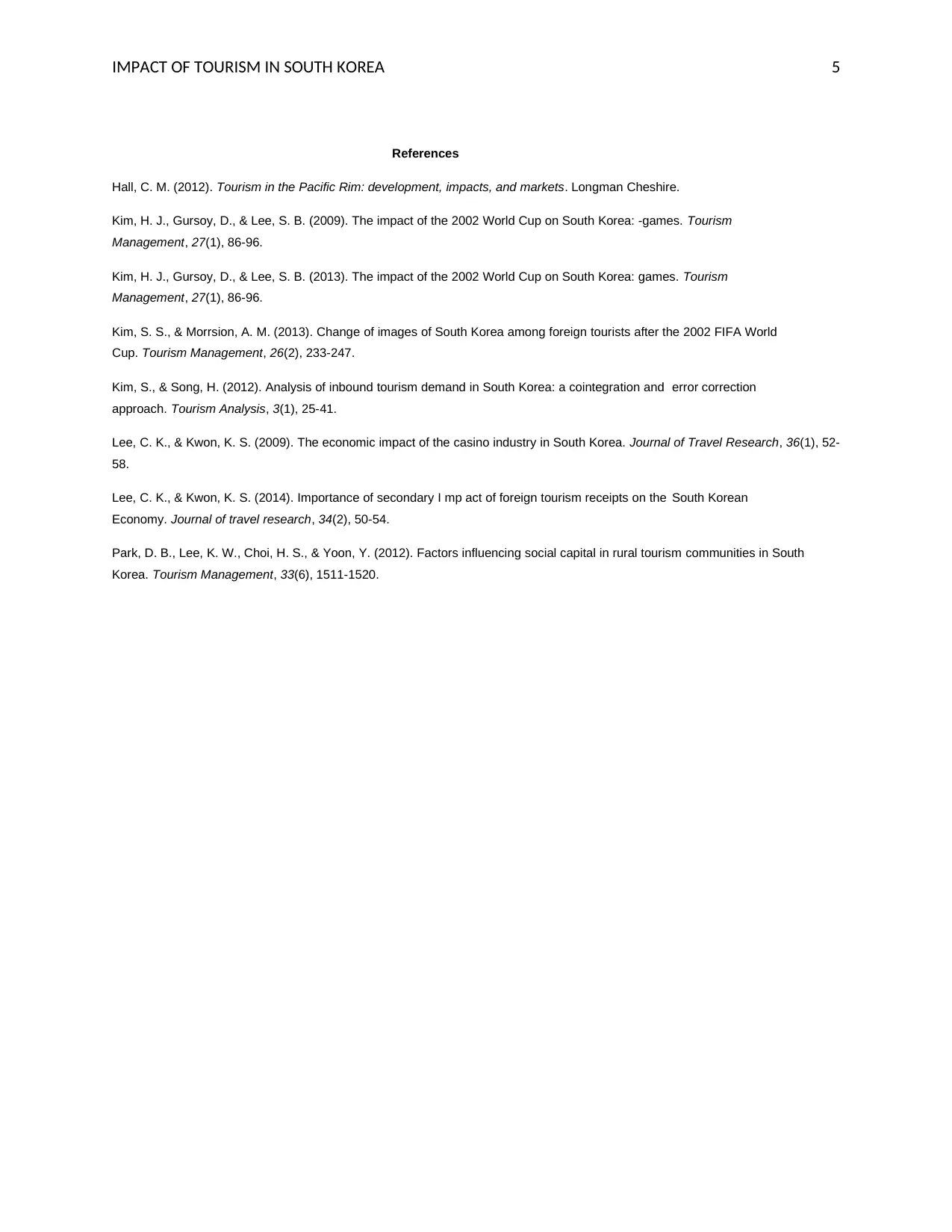
IMPACT OF TOURISM IN SOUTH KOREA 5
References
Hall, C. M. (2012). Tourism in the Pacific Rim: development, impacts, and markets. Longman Cheshire.
Kim, H. J., Gursoy, D., & Lee, S. B. (2009). The impact of the 2002 World Cup on South Korea: -games. Tourism
Management, 27(1), 86-96.
Kim, H. J., Gursoy, D., & Lee, S. B. (2013). The impact of the 2002 World Cup on South Korea: games. Tourism
Management, 27(1), 86-96.
Kim, S. S., & Morrsion, A. M. (2013). Change of images of South Korea among foreign tourists after the 2002 FIFA World
Cup. Tourism Management, 26(2), 233-247.
Kim, S., & Song, H. (2012). Analysis of inbound tourism demand in South Korea: a cointegration and error correction
approach. Tourism Analysis, 3(1), 25-41.
Lee, C. K., & Kwon, K. S. (2009). The economic impact of the casino industry in South Korea. Journal of Travel Research, 36(1), 52-
58.
Lee, C. K., & Kwon, K. S. (2014). Importance of secondary I mp act of foreign tourism receipts on the South Korean
Economy. Journal of travel research, 34(2), 50-54.
Park, D. B., Lee, K. W., Choi, H. S., & Yoon, Y. (2012). Factors influencing social capital in rural tourism communities in South
Korea. Tourism Management, 33(6), 1511-1520.
References
Hall, C. M. (2012). Tourism in the Pacific Rim: development, impacts, and markets. Longman Cheshire.
Kim, H. J., Gursoy, D., & Lee, S. B. (2009). The impact of the 2002 World Cup on South Korea: -games. Tourism
Management, 27(1), 86-96.
Kim, H. J., Gursoy, D., & Lee, S. B. (2013). The impact of the 2002 World Cup on South Korea: games. Tourism
Management, 27(1), 86-96.
Kim, S. S., & Morrsion, A. M. (2013). Change of images of South Korea among foreign tourists after the 2002 FIFA World
Cup. Tourism Management, 26(2), 233-247.
Kim, S., & Song, H. (2012). Analysis of inbound tourism demand in South Korea: a cointegration and error correction
approach. Tourism Analysis, 3(1), 25-41.
Lee, C. K., & Kwon, K. S. (2009). The economic impact of the casino industry in South Korea. Journal of Travel Research, 36(1), 52-
58.
Lee, C. K., & Kwon, K. S. (2014). Importance of secondary I mp act of foreign tourism receipts on the South Korean
Economy. Journal of travel research, 34(2), 50-54.
Park, D. B., Lee, K. W., Choi, H. S., & Yoon, Y. (2012). Factors influencing social capital in rural tourism communities in South
Korea. Tourism Management, 33(6), 1511-1520.
1 out of 5
Related Documents
Your All-in-One AI-Powered Toolkit for Academic Success.
+13062052269
info@desklib.com
Available 24*7 on WhatsApp / Email
![[object Object]](/_next/static/media/star-bottom.7253800d.svg)
Unlock your academic potential
Copyright © 2020–2025 A2Z Services. All Rights Reserved. Developed and managed by ZUCOL.





